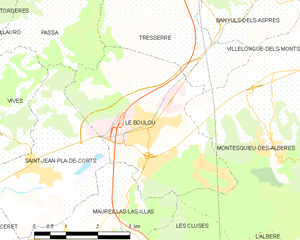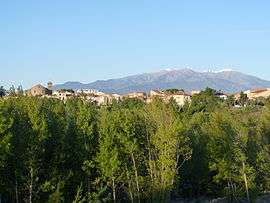Le Boulou
| Le Boulou El Voló | ||
|---|---|---|
|
A general view of Le Boulou | ||
| ||
 Le Boulou | ||
|
Location within Occitanie region  Le Boulou | ||
| Coordinates: 42°31′29″N 2°49′51″E / 42.5247°N 2.8308°ECoordinates: 42°31′29″N 2°49′51″E / 42.5247°N 2.8308°E | ||
| Country | France | |
| Region | Occitanie | |
| Department | Pyrénées-Orientales | |
| Arrondissement | Céret | |
| Canton | Céret | |
| Intercommunality | Vallespir | |
| Government | ||
| • Mayor (2014–2020) | Nicole Villard | |
| Area1 | 14.42 km2 (5.57 sq mi) | |
| Population (2012)2 | 5,520 | |
| • Density | 380/km2 (990/sq mi) | |
| Time zone | CET (UTC+1) | |
| • Summer (DST) | CEST (UTC+2) | |
| INSEE/Postal code | 66024 / 66160 | |
| Elevation | 55–363 m (180–1,191 ft) | |
|
1 French Land Register data, which excludes lakes, ponds, glaciers > 1 km² (0.386 sq mi or 247 acres) and river estuaries. 2 Population without double counting: residents of multiple communes (e.g., students and military personnel) only counted once. | ||
Le Boulou (French: [lə bu.lu]; Catalan: El Voló [əl βuˈlo]) is a commune in the Pyrénées-Orientales department in southern France.
It is situated 12 km from the Spanish border.
Geography
Localisation
The town of Le Boulou is located in the canton of Céret and in the arrondissement of Céret, in the south of Pyrénées-Orientales.

Neighbouring communes
| Passa | Tresserre | ||
| Saint-Jean-Pla-de-Corts | |
Montesquieu-des-Albères | |
| |||
| | |||
| Maureillas-las-Illas | Les Cluses (by a quadripoint) |
Toponymy
The name of the town in catalan is El Voló.[1]
History
In the 10th century, the territory of Le Boulou appears to be shared between the lord of Saint-Jean-Pla-de-Corts, lady Minimilla, and the church of Elne. Le Boulou is then ruled by the lords of Montesquieu from the 11th to the 14th centuries. It finally becomes part of the crown lands.[2]
At the end of the 17th century, Bernard de Kennedy, following the court of James II of England in France, decides to settle in Le Boulou and receives French citizenship from Louis XIV of France. His grandson, Côme de Kennedy, is granted a title of lord of Le Boulou in 1755. Côme's son, Joseph de Kennedy is the running lord during the French Revolution. But his house is used as a headquarter by the Spanish general Antonio Ricardos during the first battle of Boulou in 1793. Accused of betrayal, Joseph de Kennedy is sent to the guillotine on 2 May 1794, on the next day after the second battle of Boulou.[3]
Government and politics
Mayors
| Mayor | Term start | Term end |
|---|---|---|
| Marie-Rose Careras | 1987 | 1995 |
| Jean-Pierre Salgas | 1995 | 2008 |
| Christian Olive | 2008 |
Population
| Historical population | ||
|---|---|---|
| Year | Pop. | ±% |
| 1962 | 2,512 | — |
| 1968 | 2,921 | +16.3% |
| 1975 | 3,709 | +27.0% |
| 1982 | 4,292 | +15.7% |
| 1990 | 4,436 | +3.4% |
| 1999 | 4,428 | −0.2% |
| 2006 | 5,066 | +14.4% |
| 2009 | 5,410 | +6.8% |
See also
References
- ↑ Nomenclàtor toponímic de la Catalunya del Nord
- ↑ (French) Jean Sagnes (dir.), Le pays catalan, t. 2, Pau, Société nouvelle d'éditions régionales, 1985
- ↑ Cárdenas, Fabricio (2014). 66 petites histoires du Pays Catalan [66 Little Stories of Catalan Country] (in French). Perpignan: Ultima Necat. ISBN 978-2-36771-006-8. OCLC 893847466.
| Wikimedia Commons has media related to Le Boulou. |

.svg.png)
